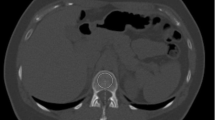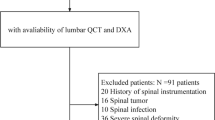Abstract
Summary
Osteoporosis remains under-diagnosed. Routine abdominal CT can provide opportunistic screening, but the effect of IV contrast is largely unknown. The overall performance for predicting osteoporosis was similar between enhanced and unenhanced scans. Therefore, both non-contrast and contrast-enhanced abdominal CT scans can be employed for opportunistic osteoporosis screening.
Introduction
Osteoporosis is an important yet under-diagnosed public health concern. Lumbar attenuation measurement at routine abdominal CT can provide a simple opportunistic initial screen, but the effect of IV contrast has not been fully evaluated.
Methods
Mean trabecular CT attenuation values (in Hounsfield units, HU) at the L1 vertebral level were measured by oval region-of-interest (ROI) on both the unenhanced and IV-contrast-enhanced CT series in 157 adults (mean age, 62.0). All patients underwent correlative central DXA within 6 months of CT. Based on DXA BMD of the lumbar spine, femoral neck, and total proximal femur: osteoporosis, osteopenia, and normal BMD was present in 33, 77, and 47, respectively. Statistical analysis included Bland-Altman plots and receiver operating characteristic (ROC) curves.
Results
Mean difference (±SD) in L1 trabecular attenuation between enhanced and unenhanced CT series was +11.2 HU (±19.2) (95 % CI, 8.16–14.22 HU), an 8 % difference. Intra-patient variation was substantial, but no overall trend in the HU difference was seen according to underlying BMD. ROC area under the curve (AUC) for unenhanced and enhanced CT for diagnosing osteoporosis were similar at 0.818 and 0.830, respectively (p = 0.632). Thresholds for maintaining 90 % specificity for osteoporosis were 90 HU for unenhanced and 102 HU for enhanced CT. Thresholds for maintaining 90 % sensitivity for osteoporosis were 139 HU for unenhanced and 144 HU for enhanced CT. Similar diagnostic performance was seen for diagnosing low BMD (osteoporosis or osteopenia) using higher HU cut-offs.
Conclusion
Contrast-enhanced CT shows an average increase of 11 HU over the unenhanced series for L1 trabecular attenuation. The overall performance for predicting osteoporosis is similar between the enhanced and unenhanced scans, thus either can be employed for initial opportunistic screening.




Similar content being viewed by others
References
Looker AC, Borrud LG, Dawson-Hughes B, Shepherd JA, Wright NC. (2012) Osteoporosis or low bone mass at the femur neck or lumbar spine in older adults: United States, 2005–2008. NCHS data brief :1–8
Kanis JA (2007) WHO technical report. University of Sheffield, UK
Johnell O, Kanis JA (2006) An estimate of the worldwide prevalence and disability associated with osteoporotic fractures. Osteopo Int : J Estab Res Coop Between Europ Found Osteopo Natl Osteop Found USA 17:1726–1733
Kanis JA, Delmas P, Burckhardt P, Cooper C, Torgerson D (1997) Guidelines for diagnosis and management of osteoporosis. The European Foundation for Osteoporosis and Bone Disease. Osteopo Int : J Estab Res Coop Between Europ Found Osteopo Natl Osteop Found USA 7:390–406
Morris CA, Cabral D, Cheng H et al (2004) Patterns of bone mineral density testing: current guidelines, testing rates, and interventions. J Gen Intern Med 19:783–790
Feldstein A, Elmer PJ, Orwoll E, Herson M, Hillier T (2003) Bone mineral density measurement and treatment for osteoporosis in older individuals with fractures: a gap in evidence-based practice guideline implementation. Arch Intern Med 163:2165–2172
Feldstein AC, Nichols GA, Elmer PJ, Smith DH, Aickin M, Herson M (2003) Older women with fractures: patients falling through the cracks of guideline-recommended osteoporosis screening and treatment. J Bone Joint Surg Am 85-A:2294–2302
Freedman KB, Kaplan FS, Bilker WB, Strom BL, Lowe RA (2000) Treatment of osteoporosis: are physicians missing an opportunity? J Bone Joint Surg Am 82-A:1063–1070
Siris ES, Miller PD, Barrett-Connor E et al (2001) Identification and fracture outcomes of undiagnosed low bone mineral density in postmenopausal women: results from the National Osteoporosis Risk Assessment. JAMA : J Am Med Assoc 286:2815–2822
Nguyen TV, Center JR, Eisman JA (2004) Osteoporosis: underrated, underdiagnosed and undertreated. Med J Austral 180:S18–S22
Levis S, Theodore G (2012) Summary of AHRQ’s comparative effectiveness review of treatment to prevent fractures in men and women with low bone density or osteoporosis: update of the 2007 report. J Manag Care Pharm 18:S1–S15
Lafata JE, Kolk D, Peterson EL et al (2007) Improving osteoporosis screening: results from a randomized cluster trial. J Gen Intern Med 22:346–351
Carberry GA, Pooler BD, Binkley N, Lauder TB, Bruce RJ, Pickhardt PJ (2013) Unreported vertebral body compression fractures at abdominal multidetector CT. Radiology 268:120–126
Pickhardt P, Bodeen G, Brett A, Brown JK, Binkley N. (2015) Comparison of femoral neck BMD evaluation obtained using lunar DXA and QCT with asynchronous calibration from CT colonography. J Clin Densitom 18:5–12
Pickhardt PJ, Lee LJ, del Rio AM et al (2011) Simultaneous screening for osteoporosis at CT colonography: bone mineral density assessment using MDCT attenuation techniques compared with the DXA reference standard. J Bone Miner Res 26:2194–2203
Pickhardt PJ, Pooler BD, Lauder T, del Rio AM, Bruce RJ, Binkley N (2013) Opportunistic screening for osteoporosis using abdominal computed tomography scans obtained for other indications. Ann Intern Med 158:588−+
Summers RM, Baecher N, Yao J et al (2011) Feasibility of simultaneous computed tomographic colonography and fully automated bone mineral densitometry in a single examination. J Comput Assist Tomogr 35:212–216
Bauer JS, Henning TD, Mueeller D, Lu Y, Majumdar S, Link TM (2007) Volumetric quantitative CT of the spine and hip derived from contrast-enhanced MDCT: conversion factors. Am J Roentgenol 188:1294–1301
Acu K, Scheel M, Issever AS (2014) Time dependency of bone density estimation from computed tomography with intravenous contrast agent administration. Osteoporo Int 25:535–542
Hopper KD, Wang MP, Kunselman AR (2000) The use of clinical CT for baseline bone density assessment. J Comput Assist Tomogr 24:896–899
Baim S, Binkley N, Bilezikian JR et al (2008) Official positions of the International Society for Clinical Densitometry and executive summary of the 2007 ISCD Position Development Conference. J Clin Densitom 11:75–91
Conflicts of interest
Dr. Pickhardt is co-founder of VirtuoCTC, shareholder in Cellectar Biosciences, and consultant for Check-Cap, KIT, and Bracco; Drs. Lauder, Pooler, Muñoz del Rio, Rosas, Bruce, and Binkley declare that they have no conflicts of interest.
Author information
Authors and Affiliations
Corresponding author
Rights and permissions
About this article
Cite this article
Pickhardt, P.J., Lauder, T., Pooler, B.D. et al. Effect of IV contrast on lumbar trabecular attenuation at routine abdominal CT: correlation with DXA and implications for opportunistic osteoporosis screening. Osteoporos Int 27, 147–152 (2016). https://doi.org/10.1007/s00198-015-3224-9
Received:
Accepted:
Published:
Issue Date:
DOI: https://doi.org/10.1007/s00198-015-3224-9




